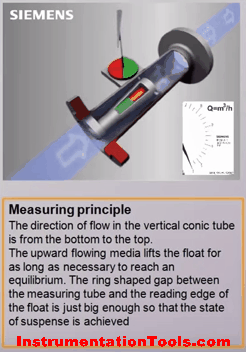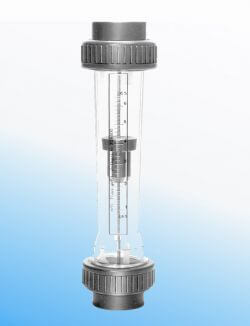A rotameter is a device that measures the flow rate of liquid or gas in a closed tube.
Rotameter belongs to a class of meters called variable area meters, which measure flow rate by allowing the cross-sectional area the fluid travels through, to vary, causing a measurable effect.
Rotameter

A rotameter consists of a tapered tube, typically made of glass with a ‘float’, made either of anodized aluminum or ceramic, actually a shaped weight, inside that is pushed up by the drag force of the flow and pulled down by gravity.
The drag force for a given fluid and float cross-section is a function of flow speed squared only.
A higher volumetric flow rate through a given area increases flow speed and drag force, so the float will be pushed upwards.
However, as the inside of the rotameter is cone-shaped (widens), the area around the float through which the medium flows increases, and the flow speed and drag force decrease until there is mechanical equilibrium with the float’s weight.
Floats are made in many different shapes, with spheres and ellipsoids being the most common. The float may be diagonally grooved and partially colored so that it rotates axially as the fluid passes.
This shows if the float is stuck since it will only rotate if it is free. Readings are usually taken at the top of the widest part of the float; the center for an ellipsoid, or the top for a cylinder. Some manufacturers use a different standard.

The “float” must not float in the fluid: it has to have a higher density than the fluid, otherwise, it will float to the top even if there is no flow.
The mechanical nature of the measuring principle provides a flow measurement device that does not require any electrical power. If the tube is made of metal, the float position is transferred to an external indicator via a magnetic coupling.
This capability has considerably expanded the range of applications for the variable area flow meter since the measurement can observed remotely from the process or used for automatic control.
Advantages of Rotameter
- A rotameter requires no external power or fuel, it uses only the inherent properties of the fluid, along with gravity, to measure flow rate.
- A rotameter is also a relatively simple device that can be mass-manufactured out of cheap materials, allowing for its widespread use.
- Since the area of the flow passage increases as the float moves up the tube, the scale is approximately linear.
- Clear glass is used which is highly resistant to thermal shock and chemical action.
Disadvantages of Rotameter
- Due to its use of gravity, a rotameter must always be vertically oriented and right way up, with the fluid flowing upward.
- Due to its reliance on the ability of the fluid or gas to displace the float, graduations on a given rotameter will only be accurate for a given substance at a given temperature. The main property of importance is the density of the fluid; however, viscosity may also be significant. Floats are ideally designed to be insensitive to viscosity; however, this is seldom verifiable from manufacturers’ specifications. Either separate rotameters for different densities and viscosities may be used, or multiple scales on the same rotameter can be used.
- Due to the direct flow indication the resolution is relatively poor compared to other measurement principles. Readout uncertainty gets worse near the bottom of the scale. Oscillations of the float and parallax may further increase the uncertainty of the measurement.
- Since the float must be read through the flowing medium, some fluids may obscure the reading. A transducer may be required for electronically measuring the position of the float.
- Rotameters are not easily adapted for reading by machine; although magnetic floats that drive a follower outside the tube are available.
- Rotameters are not generally manufactured in sizes greater than 6 inches/150 mm, but bypass designs are sometimes used on very large pipes.
If you liked this article, then please subscribe to our YouTube Channel for Instrumentation, Electrical, PLC, and SCADA video tutorials.
You can also follow us on Facebook and Twitter to receive daily updates.
Read Next:
- Variable Flow Meter Theory
- Calibrate Different Flow Meters
- Turbine Flow Meter Verification
- Calibration Turbine Flow Meter
- Orifice Flow Meter Specification